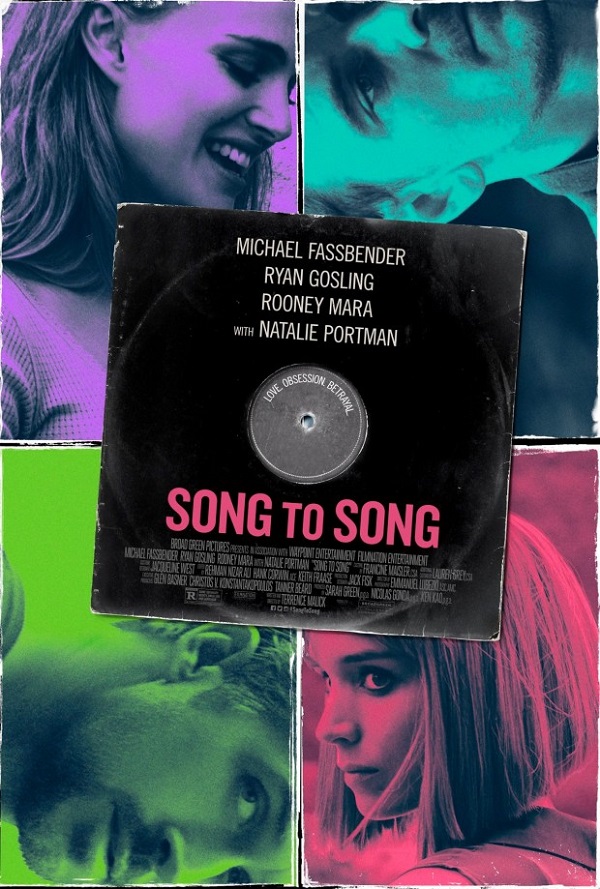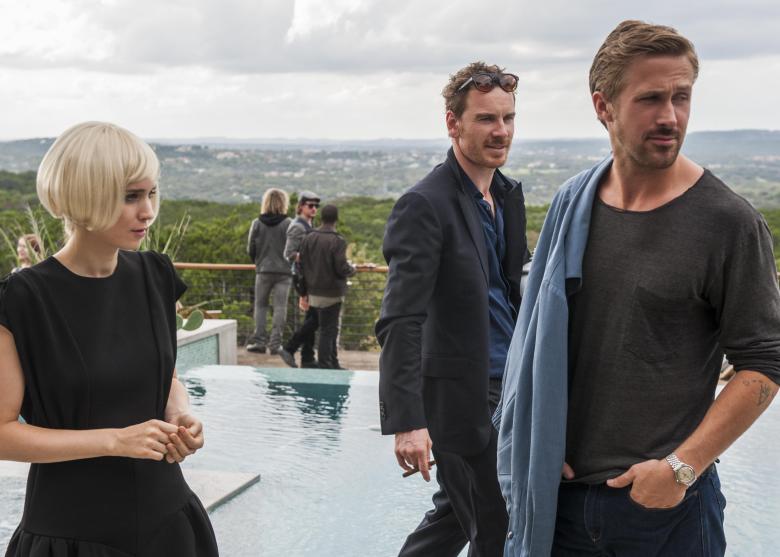By Eric Blume
 It’s difficult to review Song to Song, the latest film from Terrence Malick, because based on the standards of cinema (plot, characters, structure, acting, etc.), it’s a pretty terrible movie. But with this film, Malick continues his journey to discover some sort of new cinematic language and style that has a weird beauty all its own.
It’s difficult to review Song to Song, the latest film from Terrence Malick, because based on the standards of cinema (plot, characters, structure, acting, etc.), it’s a pretty terrible movie. But with this film, Malick continues his journey to discover some sort of new cinematic language and style that has a weird beauty all its own.
The story, such as it is, revolves around three people in the music business (played by Michael Fassbender, Rooney Mara, and Ryan Gosling). They go in and out of relationships with each other and a few other folks (notably Natalie Portman, Cate Blanchett, and Bond girl Berenice Marlohe). Malick gives you no real sense of time, so it’s never 100% clear what happens when exactly. But there are many, many scenes with those five people running their hands over each others’ bodies while voiceover proclaims banalities about sex and connection...
Your tolerance for this approach can probably be judged by your overall feelings about Tree of Life. In that film, Malick combined traditional scenes (kitchen-sink type stuff with Brad Pitt and his boys) with esoteric mediations on the life cycle where we’d see endless images of Jessica Chastain in wheat fields. In Song to Song, Malick eschews all traditional scenes: there’s barely one real, sustained scene in the picture. Instead, he performs an admittedly elegant technique where he uses a combination of sound bridges and jump cuts to touch upon one or two elements of the scene to give you a glimpse of the characters’ relationships. My guess is that he had the actors improvise endlessly, and then in the edit bay he did his infamous slashing to capture just a lingering moment from each. While it’s fun to imagine these huge movie stars seeing this movie for the first time and thinking “damn it, we spent all day doing that scene and now it’s in there for fifteen seconds,” that’s the only joy to be derived from this style. We never get a sense of who the characters are, what their real connection is to each other, etc. There’s no depth, and no shaped drama. While I realize that is the point, you don’t feel anything: Malick has several of cinema’s greatest actors at his disposal, and even they can’t make you care about who they’re playing.

While Malick’s method feels ponderous and a bit pretentious, it also yields several beautiful images. His collaboration with Emmanuel Lubezki here results in a constantly-roaming camera that picks up lovely small details, and in the few brief scenes in the film, they avoid the standard shot/reverse shot language in a way that keeps the movie fluid and alive. But what they can’t capture is any kind of dreamy tension, like David Lynch delivers when he goes more “experimental”. After about twenty minutes, the monotonous pace becomes insurmountable, and there’s still almost two more hours to go at that point.
The male actors come off stronger than the women. If anything, this film serves as an excellent time capsule for seizing Fassbender and Gosling’s immense charm, charisma, and beauty. They’re at the peak of their powers as movie stars, and they help propel the film and sustain some sense of interest. Mara has estimable skill, but she’s not exactly known for her warmth, and her character remains at a distance. You know the actress is in deep with her character, but she’s unable to translate any tangible sense of her arc to the audience.
The entire way the women are costumed and shot in this movie seems somewhat creepy-old-man-like. Portman is dressed in a series of absurdly tight, low-cut sweaters and booty-hugging jean shorts, and when Mara enters a relationship with Marlohe, the film enters a truly weird, gauzy universe that borders on softcore porn. On some level, Song to Song is about sex (I think), but Malick treats the sex in the film both with kid gloves and a complete lack of eroticism. There’s a lot of touching in the movie that after a while borders on a parody of modern dance…it’s truly bizarre!

Song to Song is a tough movie. You see Malick’s beauty as an artist, and you want to pull for him for trying something new and interesting. But he doesn’t make it easy for you, and it’s difficult to imagine people connecting with the film.